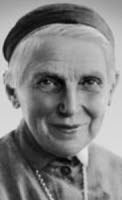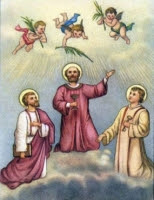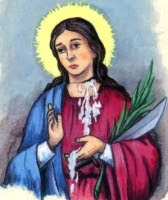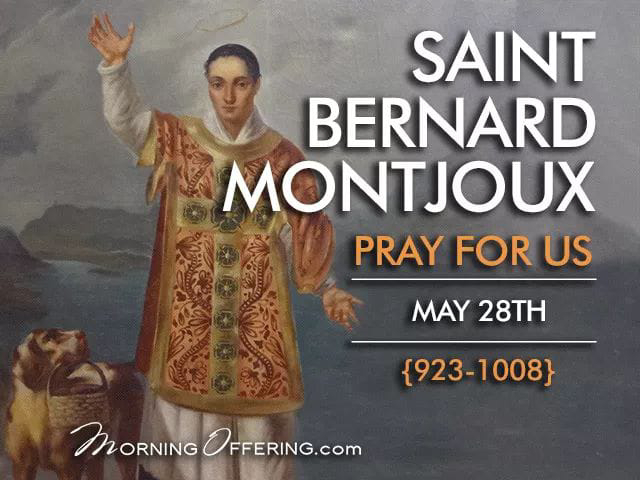
Also known as
Giovanni Battista Montini
Profile
Son of a prominent newspaper editor. Ordained in Brescia, Italy on 29 May 1920, he continued his studies in Rome, Italy, and became part of the Vatican secretariat of state in 1922. One of two pro-secretaries to Pope Pius XII. Archbishop of Milan from 1954 to 1963 where he worked on social problems and to improve relations between workers and employers. Created cardinal-priest of Santi Silvestro e Martino ai Monti on 15 December 1958. Elected 262nd Pope in 1963.
As Pope, Paul continued the reforms of John XXIII. He re-convened the Second Vatican Council, and supervised implementations of many of its reforms, such as the vernacularization and reform of the liturgy. He instituted an international synod of bishops; bishops were instructed to set up councils of priests in their own dioceses. Powers of dispensation devolved from the Roman Curia onto the bishops, rules on fasting and abstinence were relaxed, and some restrictions on inter-marriage were lifted. A commission to revise canon law revision was established.
In 1964, Paul made a pilgrimage to the Holy Lands, becoming the first pope in over 150 years to leave Italy. That was followed by trips to India in 1964, the United States in 1965, where he addressed the United Nations, Africa in 1969, and Southeast Asia in 1970. Relations between the Vatican and the Communists improved, and Communist leaders visited the Vatican for the first time. Paul met with leaders of other churches, and in 1969 addressed the World Council of Churches, and limited doctrinal agreements were reached with the Anglicans and Lutherans. Paul issued frequent reassertions of papal primacy in the face of growing dissent within the Roman Catholic Church itself. He enlarged the college of cardinals, and added cardinals from third world countries.
In the 1968 encyclical Humanae Vitae, Paul reaffirmed the church’s ban on contraception, a disappointment to many liberals. It led to protests, and many national hierarchies openly modified the statement. Liberals raised questions about priestly celibacy, divorce, and the role of women in the church, but Paul held to traditional Church positions.
Born
26 September 1897 at Concesio, Lombardy, Italy as Giovanni Battista Montini
Papal Ascension
21 June 1963
Died
6 August 1978 at Castelgandolfo, Rome, Italy of natural causes
Beatified
• 19 October 2014 by Pope Francis
• the beatification miracle involved the healing in utero of an infant that doctors had diagnosed as disabled and encouraged the mother to abort; she refused, trusted to the intercession of Blessed Paul, and the infant survived with no health concerns at all
Canonized
• on 6 March 2018, Pope Francis promulgated a decree of a miracle obtained through the intervention of Blessed Paul
• the canonization miracle involved the healing of a mother and unborn child in the 5th month of pregnancy
• canonization tentatively planned for late October 2018 following a synod of bishops
Saint Ursula Ledochowska

Also known as
• Julia Ledóchowska
• Urszula Ledóchowska
Profile
Daughter of Count Anthony Ledochowska, a Polish noble, and an Austrian mother. One of five children in a pious family; sister of Saint Theresa Ledochowska. Due to financial failure, the family moved to Saint Poelten, Austria in 1873. Her father died of smallpox in February 1885, and Julia's uncle Cardinal Lebo assumed responsibility for them.
Julia felt a call to religious life, and became an Ursuline nun, taking the name Ursula. Founded the Ursulines of the Sacred Heart (Ursuline Sisters of the Agonizing Heart of Jesus, Gray Ursulines) in 1906 with the motherhouse in Pniewy, Poland. Missionary to Russia in 1907 by order of Pope Pius X. Expelled during the Communist Revolution, she continued her work throughout Scandanavia. Translated and published a catechism in Finnish. At the request of Pope Benedict XV, she moved to Rome. From there she administered her Order, and inspired others. A noted orator, she frequently spoke before royalty and national leaders. Called for, and defended the right of Polish independence. The Gray Ursulines continue their work today in Poland, Italy, France, Canada, Brazil, Argentina, Finland, Germany, Tanzania, Belarus, and Ukraine.
Born
17 April 1865 at Loosdoor, Austria as Julia Ledóchowska
Died
• 29 May 1939 in the Gray Ursuline convent, Via del Casalet, Rome, Italy of natural causes
• incorrupt body transferred to the Gray Ursuline motherhouse in Pniewy, Poland on 29 May 1989
Canonized
18 May 2003 by Pope John Paul II at Vatican Basilica
Saint Maximinus of Trier

Also known as
Maximin
Profile
Born to the Gallic nobility. Brother of Saint Maxentius of Poitiers. Educated and ordained by Saint Agritius, whom he succeeded as bishop of Trier in 332 or 335. Trier was the government seat of the Western Empire, and his office put Maximinus close contact with Emperors Constantine II and Constans. Friend of Saint Athanasius of Alexandria, whom he harboured as an honoured guest during his exile from 336 to 338. Received the banished patriarch Paul of Constantinople in 341, and effected his return to Constantinople.
Fought Arianism. When four Arian bishops came to Trier in 342 to sway Emperor Constans, Maximinus refused to receive them, and convinced the emperor to reject their proposals. With Pope Julius I and Bishop Hosius of Cordova, he persuaded Emperor Constans to convene the Synod of Sardica in 343, and probably took part in it. Arians considered him one of their chief opponents, and they condemned him by name at their synod of Philippopolis in 343. In 345 he took part in the Synod of Milan, Italy. Presided over a synod at Cologne, Germany in 346 where Bishop Euphratas of Cologne was deposed due to his leanings toward Arianism.
Sent Saint Castor and Saint Lubentius as missionaries to the valleys of the Mosel and the Lahn. His cult began right after his death.
Born
at Silly near Poitiers, France
Died
• 12 September 349 or 29 May 352 (records vary)
• in autumn 353, he was buried in the church of Saint John near Trier
• in the 7th century the Benedictine abbey of Saint Maximinus was founded there, which flourished till 1802
Patronage
Trier, Germany
Blessed Richard Thirkeld
Also known as
Richard Thirkild
Additional Memorials
• 29 October as one of the Martyrs of Douai
• 1 December as one of the Martyrs of Oxford University
Profile
Educated at Queen's College, Oxford, 1564 - 1565. Studied at Douai and Rheims, France. Ordained on 18 April 1579 at an age somewhat older than his confreres. Returned to England on 23 May 1579 as a home missioner around York. Confessor to Saint Margaret Clitherow. Arrested on Annunciation Eve in 1583 for the crime of priesthood; the authorities became suspicious when he visited a Catholic prisoner. Lodged in Ousebridge Kidcote prison, York, for two months. He wore a cassock to trial, was convicted on 27 May 1583 of hearing confessions and bringing the lapsed back to the Church, and was sentenced on 28 May 1583 to death. He used his time in jail to minister to other prisoners, working especially with others sentenced to death. Martyred in secret for fear his covert parishioners would cause a civil disturbance. Six of his letters have survived.
Born
at Coniscliffe, Durham, England
Died
hanged, drawn, and quartered on 29 May 1583 at York, England
Beatified
29 December 1886 by Pope Leo XIII (cultus confirmation)
Saint Bona of Pisa

Profile
Mystic and visionary from her childhood. Augustinian tertiary by age 10. Pilgrim to the Holy Lands at age 14, travelling to see her father who was fighting in the Crusades. On the way home she was captured and imprisoned by Islamic pirates in the Mediterranean, but was rescued by fellow Pisan Christians. Pilgrim to Rome, Italy. Pilgrim to Santiago de Compostela, Spain nine times, leading groups of pilgrims each time, which led to several of her areas of patronage.
Born
c.1156 at Pisa, Italy
Died
• c.1207 at Pisa, Italy of natural causes
• interred at the church of San Martino in Pisa
Patronage
• air hosts, air hostesses, air stewards, flight attendants, stewardesses (chosen by Pope John XXIII in 1962)
• couriers
• guides
• pilgrims
• travellers
• Pisa, Italy
Saint Conon the Elder
Also known as
Cuomo the Elder
Profile
Father of Conon the Younger. On the death of his wife, the Elder urged his son to religious life, and lived as a hermit himself. He and his son were charged with the treason of being Christian; both freely admitted it. Tortured and martyred.
Born
Iconium, Asia Minor
Died
• roasted over a fire and then racked to death in 275
• relics translated to Acerra, Italy
Patronage
Acerra, Italy
Saint Cyril of Caesarea

Also known as
Cyril of Kayseri
Profile
Raised in a wealthy pagan family, in his youth Cyril was baptized in secret. When his family learned of his conversion, his father banished him from the family estate. Cyril was imprisoned for his faith, and ordered by local officials to renounce Christianity and sacrifice to idols; he refused. Martyr.
Died
beheaded in 251 in Caesarea, Cappadocia
Saint Conon the Younger
Also known as
• Cuomo the Younger
• Cuono, Conello
Profile
Son of Saint Conon the Elder. A pious youth, he was a lector at age 12. Deacon. He and his father were charged with the treason of being Christian; he freely admitted it. Tortured and martyred.
Born
Iconium, Asia Minor
Died
• slowly roasted over a fire, and then racked to death in 275
• relics translated to Acerra, Italy
Patronage
Acerra, Italy
Blessed Gerardesca

Also known as
Gherardesca
Profile
Lay woman who married young and had several children. She eventually convinced her husband to become a Camaldolese monk at San Salvio. She lived nearby as a recluse, under the obedience of the abbey, but without taking orders.
Born
c.1200 at Pisa, Italy
Died
c.1265 of natural causes
Beatified
1856 by Pope Pius IX (cultus confirmed)
Blessed Giles Dalmasia

Also known as
Egidio
Profile
Obtained a degree in theology. Mercedarian. While suffering regular beatings and abuse for being a Christian, he not only ransomed many Christian slaves in Africa, he converted others to the faith. Martyr.
Died
1399 in Africa
Saint Hesychius of Antioch
Also known as
Esichio
Profile
Imperial Roman soldier during a period of persecution. Suddenly moved to proclaim his faith, he threw off his military belt and announced himself a Christian. He was promptly executed. Martyr.
Died
drowned c.303 in the River Orontes near Antioch (modern Antakya, Turkey)
Saint Felix de Atarés
Profile
Brother of Saint Votus. Hermit in the Pyranees mountains under a huge rock on which the Benedictine abbey of San Juan de Peña, a cradle of Christianity in Navarre and Aragon, was later built.
Born
Saragossa, Spain
Died
c.750 of natural causes
Saint Votus de Atarés
Profile
Brother of Saint Felix. Hermit in the Pyranees mountains under a huge rock on which the Benedictine abbey of San Juan de Peña, a cradle of Christianity in Navarre and Aragon, was later built.
Born
Saragossa, Spain
Died
c.750 of natural causes
Saint John de Atarés
Profile
Hermit in the diocese of Jaca, Aragonese Pyrenees (in modern Spain). His cell was under a huge rock on which the Benedictine abbey of San Juan de Peña, a cradle of Christianity in Navarre and Aragon, was later built.
Died
c.750 of natural causes
Saint Daganus
Profile
Bishop honoured in Galloway, Scotland, who was known for his personal piety. Involved in the dispute over using the Roman or Celtic computation for Easter. Saint Bede the Venerable wrote about him, and his name is part of the Dunkeld Litany.
Died
c.609 of natural causes
Saint Eleutherius of Rocca d'Arce
Profile
Brother of Saint Grimwald and Saint Fulk. Died while on pilgramage.
Born
England
Died
Rocca d'Arce, Italy of natural causes
Patronage
Rocca d'Arce, Italy
Saint Senator of Milan
Profile
Priest. Papal legate to the Byzantine court of Theodosius II for Pope Saint Leo the Great. Attended the Council of Chalcedon. Archbishop of Milan, Italy in 472.
Born
Milan, Italy
Died
480 of natural causes
Saint Gerald of Mâcon
Also known as
Gerardo
Profile
Benedictine monk at Brou. Bishop of Mâcon, France for 40 years, but in his old age he resigned and retired to his old monastery to live as a hermit.
Died
927
Saint Theodosia of Caesarea
Profile
Martyred in the persecutions of Diocletian; she died with 12 other Christian women, but none of their names have come down to us.
Died
303 in Caesarea, Palestine
Saint Restitutus of Rome
Profile
Martyred in the persecutions of Diocletian.
Died
c.299 in Rome, Italy
Saint Maximus of Verona
Profile
Sixth-century bishop of Verona, Italy.
Martyrs of Toulouse

Also known as
Martyrs of Avignonet
Profile
A group of eleven Dominicans, Franciscans, Benedictines, clergy and lay brothers who worked with the Inquisition in southern France to oppose the Albigensian heresy. Basing their operations in a farmhouse outside Avignonet, France, he and his brother missioners worked against heresy. Murdered by Albigensian heretics while singing the Te Deum on the eve of Ascension.
• Adhemar
• Bernard of Roquefort
• Bernard of Toulouse
• Fortanerio
• Garcia d'Aure
• Pietro d'Arnaud
• Raymond Carbonius
• Raymond di Cortisan
• Stephen Saint-Thibery
• William Arnaud
• the prior of Avignonet whose name unfortunately has not come down to us
The church in which they died was placed under interdict as punishment to the locals for the offense. Shortly after the interdict was finally lifted, a large statue of the Blessed Virgin Mary was found on the door step of church. Neither the sculptor nor the patron was ever discovered, nor who delivered it or how. The people took it as a sign that they were forgiven, but that they should never forget, and should renew their devotion to Our Lady. They referred to the image as "Our Lady of Miracles".
Until recently there was a ceremony in the church on the night of the 28th to 29th of May, the anniversary of the martyrdom. Called "The Ceremony of the Vow", parishioners would gather in the church, kneel with lit candles, and process across the church on their knees, all the while praying for the souls of the heretics who had murdered the martyrs.
Died
beaten to death on the night of 28 to 29 May 1242 in the church of Avignonet, Toulouse, France
Beatified
1 September 1866 by Pope Pius IX (cultus confirmation)
Martyrs of Trentino

Also known as
Martyrs of Cappadocia
Profile
Three missionaries to the Tyrol region of Austria, sent by Saint Ambrose of Milan and welcomed by Saint Vigilius of Trent. All were martyred - Alexander, Martyrius and Sis
Born
Cappadocia
Died
397 in Austria

























